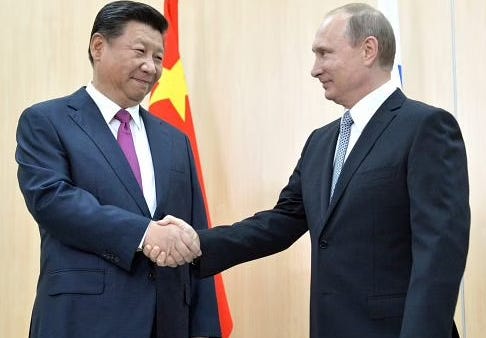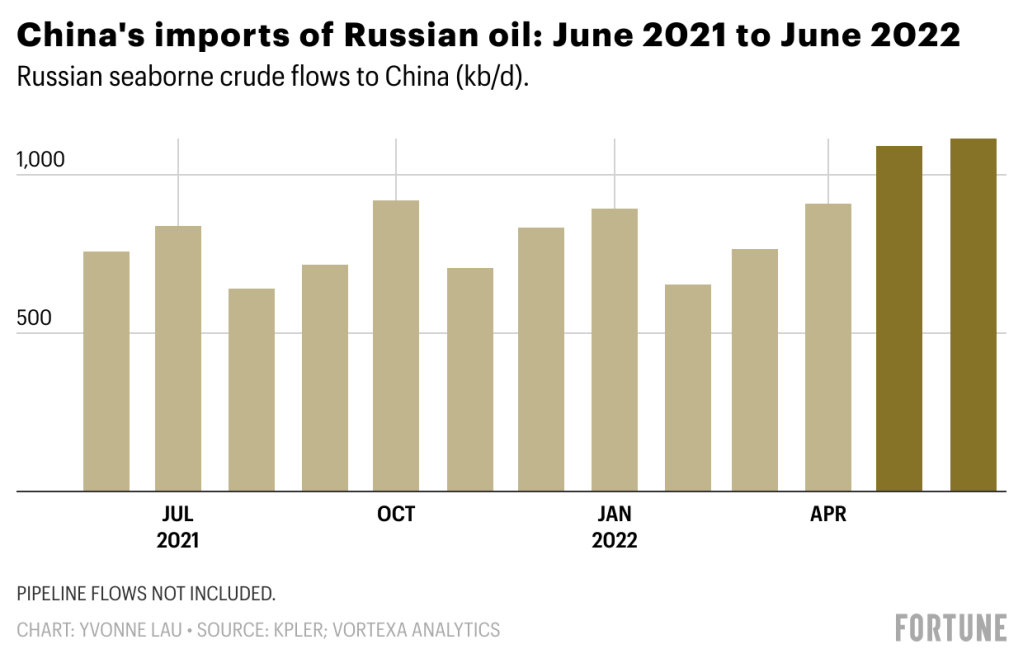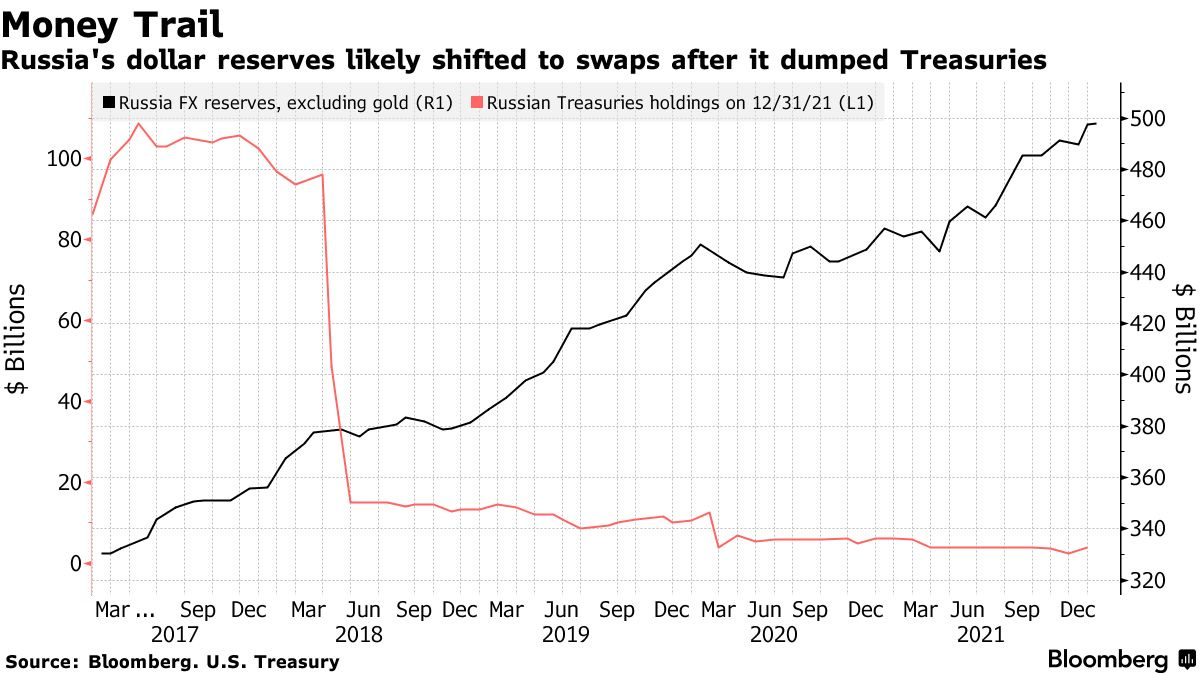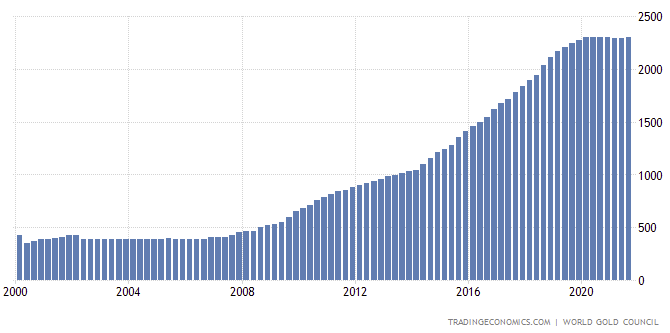http://www.informationclearinghouse.info/57137.htm
Russia And China Officially Announce A "New Global Reserve Currency"
And once again, as happens often with consequential news in the United States and the West, no one has noticed and no one seems to care.
If you’ve blinked over the last month, you may have missed it…
China and Russia are taking their shot at the U.S. dollar. And as often happens with consequential news in the United States and the West, no one seems to notice or even care.
Since the beginning of the year, I have been writing about the possibility of Russia and China challenging the US dollar’s global reserve status. Now, it’s happening.
It shouldn’t be any surprise to those paying attention that Russia and China are strengthening their economic ties amidst continued Western sanctions on Russia as a result of the country’s war in Ukraine.
What may surprise some people, however, is that Russia and the BRICS countries, including Brazil, Russia, India, China, and South Africa, are officially working on their own “new global reserve currency,” RT reported in late June. Nobody even seemed to notice.
“The issue of creating an international reserve currency based on a basket of currencies of our countries is being worked out,” Vladimir Putin said at the BRICS business forum last month.
And of course, as Russia has been cut off from the SWIFT system, it is also pairing with China and the BRIC nations to develop “reliable alternative mechanisms for international payments” in order to “cut reliance on the Western financial system.”
In the meantime, Russia is also taking other steps to strengthen the alliance between BRIC nations, including re-routing trade to China and India, according to CNN:
President Vladimir Putin said Wednesday that Russia is rerouting trade to "reliable international partners" such as Brazil, India, China and South Africa as the West attempts to sever economic ties.
"We are actively engaged in reorienting our trade flows and foreign economic contacts towards reliable international partners, primarily the BRICS countries," Putin said in his opening video address to the participants of the virtual BRICS Summit.
In fact, “trade between Russia and the BRICS countries increased by 38% and reached $45 billion in the first three months of the year” this year, the report says. Meanwhile, Russian crude sales to China have hit record numbers during Spring of this year, edging out Saudi Arabia as China’s primary oil supplier.
"Together with BRICS partners, we are developing reliable alternative mechanisms for international settlements," Putin said.
Putin continued, stating last month: "Contacts between Russian business circles and the business community of the BRICS countries have intensified. For example, negotiations are underway to open Indian chain stores in Russia [and to] increase the share of Chinese cars, equipment and hardware on our market."
In June, Putin also accused the West of ignoring"the basic principles of [the] market economy" such as free trade. "It undermines business interests on a global scale, negatively affecting the wellbeing of people, in effect, of all countries," he said.
President Xi echoed Putin’s sentiments, according to a June writeup by Bloomberg:
“Politicizing, instrumentalizing and weaponizing the world economy using a dominant position in the global financial system to wantonly impose sanctions would only hurt others as well as hurting oneself, leaving people around the world suffering. Those who obsess with a position of strength, expand their military alliance, and seek their own security at the expense of others will only fall into a security conundrum.”
The developments obviously further my long held belief that a gold backed global reserve currency is on its way - something I have been writing about for months.
I’m also stunned that nobody seems to care that arguably the largest shift on the global macroeconomic playing field over the last half century may be taking place.
Sure, under the context of the conflict in Ukraine, the news may seem “par for the course” of sorts, which may result in the media and the financial world downplaying it. But put this piece of information out there on its own, without context - that there is a coordinated global challenge taking place to the U.S. dollar - and it would be the biggest news story in decades. Imagine if China and Russia just dropped this out of nowhere? Now, remember that both countries have been working on, and preparing for, this situation for years.
I mean, holy hell, look at Russia’s Treasury holdings as far back as 2018:
As I’ve noted before, Russia was also increasing its holdings of gold over the same period:
And this headline came out in 2020, just months before Russia’s invasaion of Ukraine
Does anyone think it’s a coincidence?
Nikkei wrote at the time:
Dedollarization has been a priority for Russia and China since 2014, when they began expanding economic cooperation following Moscow's estrangement from the West over its annexation of Crimea. Replacing the dollar in trade settlements became a necessity to sidestep U.S. sanctions against Russia.
Ergo, it seems to me that the BRIC nations understand exactly how precarious of a financial situation the U.S. - and our dollar - is in. Despite the dollar’s recent strengthening, these nations have been in the midst of a multi-decade-long plan to de-dollarize. Even before the Ukraine conflict started, both China and Russia were stockpiling gold and working on denominating transactions outside of the U.S. dollar. It was another “secret” that was out there in the open.
Remember how “insane” this headline was just 6 months ago when I predicted it for the first time?
Everybody told me that it was a stretch. Today, it isn’t so much anymore.
Meanwhile, since the BRIC conference, ties between Russia and China continue to tighten, with Japan even warning this week about the pair’s “strengthening of military ties” - at the same time China has closely scrutinized a planned trip by House Speaker Nancy Pelosi to Taiwan.
Japan said this past week:
“As a result of the current aggression, it is possible that Russia’s national power in the medium- to longterm may decline, and the military balance within the region and military cooperation with China may change.
In the vicinity of Japan, Russia has made moves to strengthen cooperation with China, such as through joint bomber flights and joint warship sails involving the Russian and Chinese militaries, as well as moves to portray such military cooperation as strategic coordination.”
Japan said this alignment between the two countries “must continue to be closely watched in the future.”
While the economic gears turn behind the scenes, China is also becoming incresingly cagey about Taiwan. The country “has sent warplanes into Taiwan's self-declared air defense zone identification zone many times in recent months,” according to CNN, and recently alluded to the idea of a no-fly zone over Taiwan ahead of a planned visit by Nancy Pelosi.
President Biden commented on Pelosi’s travel plans this week, stating: “The military thinks it’s not a good idea right now. But I don’t know what the status of it is.”
We’re sure Pelosi will wind up going anyway. Remember, this is the same woman who danced her way through Chinatown while Covid was spreading to the U.S., from China, to prove she wasn’t racist.
I can hear her en route to Taiwan now:
....
https://www.globalresearch.ca/for-those-about-rock-nam-2-0-salutes-you/5787641
For Those About to Rock. The Non-Aligned Movement. The NAM 2.0 Drive.
Those were the days, in 1955, at the legendary Bandung conference in Indonesia, when the newly emancipated Global South started dreaming of building a new world, via what became configured later in 1961 in Belgrade as the Non-Aligned Movement (NAM).
The Empire of Chaos – and Lies – would never allow a starring role for NAM. So it played dirty: everything from hardcore subversion and bribing to military coups and proto-color revolutions.
Yet now, the Spirit of Bandung lives again, via a sort of NAM 2.0 on steroids: a Newly Aligned Movement, with the leaders of Eurasian integration at the vanguard.
We just had a taste of which way the geopolitical wind is blowing at the gathering of a new power troika in Tehran. Unlike Stalin, Roosevelt and Churchill in 1943, Putin, Raisi and Erdogan did not meet to carve up the world. They met essentially to discuss how another world is possible – through bilaterals, trilaterals, multilaterals and an enhanced role for an array of relatively new geopolitical and geoeconomic institutions.
Russia – and China – have been on the forefront of all recent key decisions. Their diplomacy has brought Iran to join the SCO as a full member. Their pull is attracting key Global South players to join BRICS+. Russia has all but convinced Turkey to join BRICS+, the SCO and the EAEU, and facilitated the re-approximation of Tehran and Ankara as well as Tehran and Riyadh. Russia has largely influenced the remake/remodel process across West Asia.
This NAM 2.0 drive – of which China is a key player – stands in stark opposition to how the Empire of Chaos – and Lies – wove its toxic net, via the war on terror, since the start of the millennium. The Empire tried to subdue what it described as MENA (Middle East-Northern Africa) on the basis of two invasions/occupations (Afghanistan-Iraq); a total devastation (Libya); and a protracted proxy war (Syria). All eventually failed.
And that brings us to the stunning contrast between these two foreign policy approaches, graphically illustrated by the spectacular failure of the teleprompter-reading “leader of the free world” in his visit to Jeddah – he was not even allowed to go to Riyadh – compared to Putin’s performance in Tehran.
Not only we are witnessing the lineaments of a Russia/Iran/Turkey informal alliance; we are witnessing the alliance reading a soft riot act to the Empire: leave Syria, before you suffer yet another humiliation. And with a Kurd-directed corollary: keep away from the Americans and recognize the authority of Damascus before it’s too late.
Ankara could never admit it in public, but the fact is Sultan Erdogan – as much against US troops in Syria as Putin and Raisi – even seems to have swiftly calibrated his previous designs on Syrian sovereign territory.
The much-debated Turkish military operation in northern Syria in the end may be restricted to taming the YPG Kurds. The heart of the action will in fact revolve around how the Russia/Iran/Turkey/Syria alliance will make like impossible for Americans stealing Syrian oil.
As Russia is now on “take no prisoners” mode when facing the collective West – the mantra in every intervention by Putin, Lavrov, Medvedev, Patrushev – and on top of it firmly aligned with China and Iran, it’s inevitable that every other player across West Asia and beyond is giving undivided attention to the new game in town.
Go Caspian, Young Man
Interconnecting West Asia and Central Asia, the Caspian Sea has finally reached the geopolitical and geoeconomic limelight – complete with the groundbreaking consensus reached by the five littoral states at the Caspian Summit in late June to officially ban NATO from these waters.
Moreover, the leadership in Tehran in no time realized how the Caspian is the perfect, cost-conscious corridor from Iran to the heart of Russia along the Volga.
So it’s no wonder that Putin himself, in Tehran, proposed the construction of a key stretch of highway on the St Petersburg-Persian Gulf route, much to the delight of the Iranians. Cue to the nostalgic Great Game crowd in that former “rule the waves” island getting serial heart attacks: they could never imagine the Russian “empire” finally having full access to the warm waters of the Persian Gulf.
So we’re back to the absolutely crucial re-engineering of the International North South Transportation Corridor (INTSC) – which will play for Russia and Iran a parallel role the Belt and Road Initiative (BRI) plays for China. In both cases, it’s all about multimodal Eurasia-wide trade and development corridors immune from interference by the imperial Navy.
And here we see the renewed importance of the hyper-strategic liberation of Mariupol and Kherson by the Russian and DPR forces. The Sea of Azov is now configured as a de facto Russian lake – and the same will eventually happen to what is bound to remain of the (currently Ukrainian) Black Sea coast, Odessa included.
So we have the ultra-strategic Caspian-Black Sea maritime corridor – via the Volga-Don canal – seamlessly connected to the Black Sea-Mediterranean, and up north, all the way to the Baltic and the fast developing Atlantic-Pacific connector, the Northern Sea Route. Call it the Russian Heartland Water Roads.
The NATO/Five Eyes/Intermarium combo has absolutely nothing to counteract these (overland) facts on the (Heartland) ground except to throw a pile of HIMARS into the Ukrainian black hole. And of course, keep de-industrializing Europe. In contrast, those across the Global South with a keen sense of history – as in the grand debate of ideas in a Hegelian sense – and also versed in geography and trade relations are busy getting ready to hit (and profit from) the new groove.
Have strategic ambiguity, will travel
As much as it’s a blast to survey all the instances of Russia playing strategic ambiguity to levels capable of baffling the entire, bloated “Western intel” apparatus, what is coming to the forefront is how Putin – and Patrushev – are now willfully turning up the pain dial to tactically exhaust not only the Ukrainian black hole but the whole of NATOstan.
Western governments are collapsing. Sanctions are being ditched – practically in secret. A Deep Freeze winter is a given. And then there’s the incoming economic/financial crisis, the Definitive Monster from Hell, as Martin Armstrong has made it quite clear: “There is no way they can get out of this other than default. If they default, they are worried about millions of people storming the parliaments of Europe…This is really a tremendous financial crisis that we are facing. They have been borrowing year after year since WWII with zero intention of paying anything back.”
Meanwhile, Moscow may be revving up the turbines to launch – this coming Fall? In the middle of Winter? Next Spring? – a multi-spectrum Mother of All Offensives, capitalizing on a rolling series of interconnected strategies that have already rendered dazed and confused every NATOstan “analyst” in sight.
That would explain Putin looking like he’s cheerfully whistling JJ Cale’s Call Me the Breeze in most of his public appearances. In his crucial intervention at the Strong Ideas for a New Time forum, he enthusiastically promoted the advent of “truly revolutionary” and “enormous” changes that would lead to the creation of a new, “harmonious, fairer and more community-focused and safe” world order.
Yet that’s not for everyone: “only truly sovereign states can ensure high growth dynamics.” What that implies is that the unipolar world order, followed by states in the collective West which are hardly sovereign, is condemned to fail, as it’s “becoming a brake on the development of our civilization.”
Only a self-confident sovereign who does not expect anything constructive from the collective West can get away with describing it as “racist and neo-colonial”, bearing an ideology that “is becoming increasingly more like totalitarianism.” In the old NAM days these words would be met with an assassination.
So will the “rules-based international order” be preserved? Not a chance, argues Putin: the changes are “irreversible.” For those about to rock, NAM 2.0 salutes you.
....
http://endoftheamericandream.com/ranchers-are-selling-of-their-cattle-in-unprecedented-numbers-due-to-the-drought-and-that-has-enormous-implications-for-2023/
Ranchers Are Selling Off Their Cattle In Unprecedented Numbers
Ranchers Are Selling Off Their Cattle In Unprecedented Numbers Due To The Drought, And That Has Enormous Implications For 202
Thanks to the horrific drought which is absolutely devastating ranching in the Southwest, ranchers are now in “panic mode” and are selling off their cattle at an unprecedented rate. In fact, some are choosing to sell off their entire herds because they feel like they don’t have any other options. In recent days, seemingly endless lines of trailers waiting to drop off cattle for auction have gone viral all over social media. Everybody is talking about how they have never seen anything like this before, and if the drought in the Southwest persists the lines could soon get even longer. In the short-term, this is going to help to stabilize meat prices. But in the long-term the size of the U.S. cattle herd will steadily become much smaller, and that has very serious implications for our ability to feed ourselves in 2023 and beyond.
North Texas has become the epicenter for this rapidly growing crisis. Thanks to the drought, there simply is not enough grass and not enough water, and so many ranchers have been forced to make some really tough decisions…
North Texas ranchers are selling off cattle by the thousands as grass and water disappear during an expanding summer drought.
Videos spread on social media Saturday and Sunday, showing trucks and trailers lined up for miles outside of livestock markets.
At the Decatur Livestock Market, owner Kimberly Irwin said trucks were stacked a mile in each direction, eventually unloading more than 2,600 animals.
For many of these ranchers, it is imperative that they get something for their animals while they still can.
According to the USDA, the vast majority of the pasture and range land in the region is now in either “poor” or “very poor” condition…
Grass has stopped growing with no rain and 100 degree temperatures. Grasshoppers have reportedly been destroying what’s available in some counties. Stock ponds are now starting to run low on water as well.
The USDA released a report Monday showing 83% of pasture and range land is now considered to be in poor to very poor condition.
Normally, many cattle ranchers would feed hay to their cattle under such circumstances, but the price of hay has absolutely skyrocketed over the past year…
Prices for hay, which is widely used to feed cattle, were 56% higher in April than in 2021, according to a June report from the Federal Reserve Bank of Kansas City. Cattle producers are estimated to have lost money the past two months, according to a cost-and-return analysis from Iowa State University.
So now even if you can find hay for sale it is usually so expensive that it is simply not economical. Without any other options that make sense, some cattle ranchers in Texas have actually decided to go ahead and sell their entire herds…
Central Texas ranchers have little hay to feed their cows due to drought conditions. That means some ranchers are now selling their entire herds, including older ones who might not thrive in the drier and hot conditions.
“Some of these ranchers are just totally out of grass, totally out of water,” Uptmore said. “Their backs are against the wall and they don’t have any other option.”
The good news is that a flood of beef is coming into the supply chain right now.
And that will certainly help keep short-term prices stable.
But what will we do next year and beyond?
According to Bloomberg, many ranchers that are showing up at these auctions are literally in “panic mode” because they are so eager to sell off their animals…
Ranchers in top cattle state Texas can’t sell their herds fast enough with 100-degree Fahrenheit temperatures making it too expensive to sustain animals.
Costs for feed, fertilizer and fuel have been soaring. There’s also a lack of water in the state, and little hay. That’s resulting in a firehouse of cattle getting auctioned at Texas sale barns. Emory Livestock Auction Inc., just over an hour’s drive east from Dallas, is seeing nearly quadruple normal rates with ranchers in “panic mode,” said Jack Robinson, an 83-year-old auctioneer.
Normally ranchers would wait until their cattle have reached a desired weight before finally selling them off.
Unfortunately, this relentless drought is forcing many ranchers to “sell smaller”…
Cattle rancher Anthony Vybiral, in the business since the 90s, says drought conditions are forcing ranchers like him to “sell smaller.”
During a normal season, calves weigh up to 600 pounds, Vyviral said. Now, the rancher said, “some of them have been weighing 375 to 450 and they’ve been selling them.”
At the end of the day, ranching is a business.
These guys are trying to make whatever money that they can under the circumstances.
Of course most Americans never even think about where the meat that they eat comes from, but we should.
Because as Texas rancher Jarrod Montford has pointed out, we depend on a very small sliver of the population to feed all the rest of us…
“1.6, 1.7% of the population feeds the rest. It’s not how bad are we at the end of the day,” Monfort said. “It’s the fact that if we don’t survive, our nation fails,” said Montford.
He is right.
We need our farmers and our ranchers, and we don’t appreciate them nearly enough.
Looking ahead, there is reason to be extremely concerned.
The national cattle herd has been getting smaller for quite a while, and now that trend threatens to greatly accelerate…
The nation’s cow herd has been shrinking for the past two years, but this summer’s drought is sending much of the breeding herd to the processing plant. That will cut into calf numbers for the next two to three years.
What we desperately need is a break in the weather.
So let us hope for cooler temperatures and lots of rain.
Unfortunately, this next week is supposed to be a sizzler, and that will especially be true in the Southwest…
About 85% of the US population — or 273 million people — could see high temperatures above 90 degrees over the next week. And about 55 million people could see high temperatures at or above 100 degrees over the next seven days.
On Saturday, “sizzling temperatures” will take hold of the Middle Mississippi Valley and Central Plains with temperatures forecast to surpass 100 degrees, the weather prediction center said.
Daytime temperatures could top 100 degrees across much of the Southwest, with some areas exceeding 110 degrees, according to the center.
Of course all of this is happening within the context of the worst global food crisis in decades.
Famines are already erupting all over the world, and global food supplies are getting tighter with each passing day.
We were warned that this was coming, but most people didn’t want to listen.
Now a day of reckoning is nearly upon us.
I would definitely encourage you to stock up on meat in the weeks ahead while it is still relatively cheap, because the outlook for 2023 and beyond is definitely not promising.








No comments:
Post a Comment